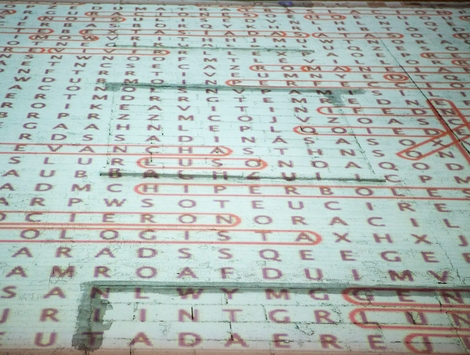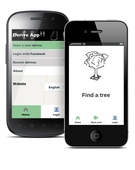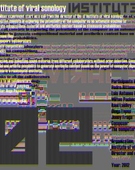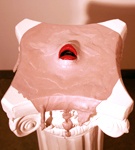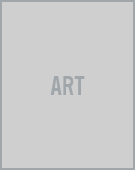The web-app Borges: The Complete Works/Obras Completas is a gigantic word-search puzzle comprising the entire literary output of Jorges Luis Borges. More than 270,000 words were encoded in two boards – in the original Spanish and in English translation – with the help of software written solely for this project. Playing online is simple and intuitive: each word circled by players in their own boards is automatically updated to a collective game, loaded with all the words yet found by anyone anywhere. The collective board updates on the fly and is exhibited in public projections, although it can be viewed by anyone via the website.
Full Description
To create the work, the collective words were first whittled down to the 17,000 unique ones. A depth-first, backtracking algorithm packed them into the smallest rectangle possible. This algorithm was designed by Temkin, using words collected by Maltz. In the original version (shown in Dec 2012 at Three Legged Dog), some words were arranged backwards or bottom-to-top, to avoid hitting the maximum size of the HTML5 canvas. However, these words were too difficult to find. For the new version, released in Sept 2014 at the DUMBO Arts Festival, a lattice of dozens of overlapping canvases were used, and no backwards words.
During the opening weekend at DUMBO Arts Fest, over 5000 words were circled, with users participating from 29 countries. Details can be seen here: http://rottytooth.tumblr.com/post/99484923306/results-from-borgeslibrary-coms-re-launch-at-dumbo
Work metadata
- Year Created: 2012
- Submitted to ArtBase: Friday Oct 31st, 2014
- Original Url: http://borgeslibrary.com/
-
Work Credits:
- Daniel Temkin, creator
- Rony Maltz, creator
Take full advantage of the ArtBase by Becoming a Member
Artist Statement
In his fiction, the Argentine writer Jorge Luis Borges conceived of such poetic paradoxes as an infinite library, a single point that contains the universe, and a map of an empire at the exact scale of that empire. His stories tackle our ludicrous search for answers to questions that have haunted humanity for millennia: the meaning of life, our origins and destiny.
In The Library of Babel (1944), Borges's words give shape to an intangible (although finite) Universe – the Library – unfolded by the combination of only a few recognizable signs – the Alphabet. It invites us to contemplate the consequences of the simple recombination of pre-existing terms, an appraisal to “the variation of the 23 letters.”
Instead of laboring big, lengthy novels, he would rather simulate that these books already existed and write their summaries. Borges's labyrinths are metaphors for time itself: all the possibilities illustrated by paths/lines that take potentially everywhere, but you can only choose one. Even going back is going somewhere else.
The word-search is analogous to this way of thinking: all the answers are available at the same time, but each reader/searcher has to dig his or hers own path into that universe. Each narrative is singular. As Borges's Library, the game is not infinite – it is self-contained in the rigidity of a grid –, but their variables are so vast that it is nearly impossible to exhaust them.
“All men should juggle letters and symbols until they constructed, by an improbable gift of chance, these canonical books”, he wrote in The Library. Here, the canon is Borges's own writing. There are many words in the board that he never wrote, neologisms, and slang that manifest by chance combinations of letters. Borges: The Complete Works is a probabilistic text, where many people, unaware of what the others are doing, collectively build something new and strange.
The array of possibilities hidden in the word-search becomes even more dramatic if we consider the range of potential translations for Borges' texts, and the linguistic differences between them. We could ultimately create a new, uncharted board for each spoken language in the world – like in Babel's tale.
